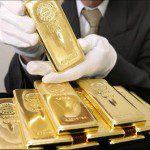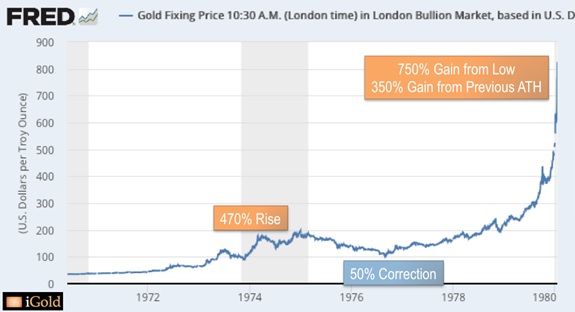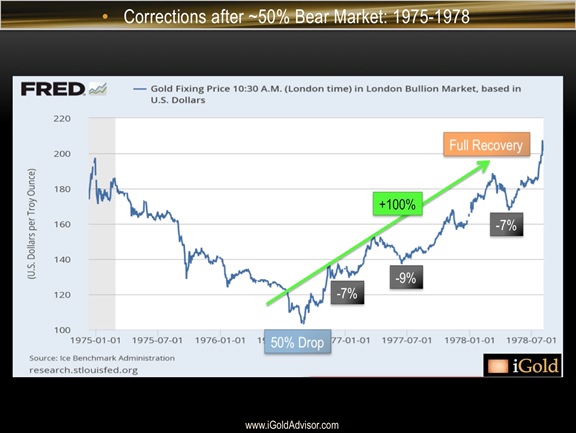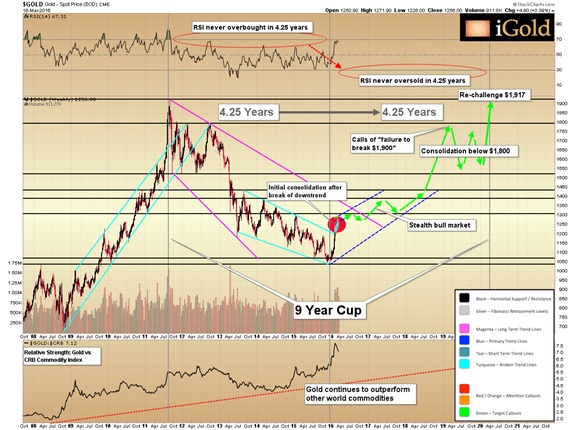What we are witnessing today is a gold recovery pricing model similar to the 1970’s but one that is taking roughly twice as long to play out. Gold prices will climb slowly, steadily and stealthily for the next 4.25 years without a significant pullback, re-challenging $1,900 by 2021.
the 1970’s but one that is taking roughly twice as long to play out. Gold prices will climb slowly, steadily and stealthily for the next 4.25 years without a significant pullback, re-challenging $1,900 by 2021.
The Gold Recovery Model
Where do we derive our model from? New readers should have a background of the 1970’s bull market in gold to properly understand this analysis.

After rising international gold demand forced President Nixon to abandon the dollar peg in 1971, gold began its first historic run from $35 to over $850 within the next nine years.
What is often overlooked during this time frame is the fact that this move occurred in two distinct waves.
- From 1971 to 1975, the price rose roughly 470%, from $35 to nearly $200.
- Next, from 1975 through mid ’76, gold lost almost 50% of its value, falling to just above $100.
- From mid ’76 to late ’77, gold rebounded completely, reaching $200 again by December of that year.
- After breaking through $200, the rest was history, as gold prices accelerated for two more years to the 1980 $850 high.
Note that during the 100% recovery during the 1970’s, gold did not register even a single 10% correction so we have a precedent for a 50% drop within an overall move higher of almost 2,400% in the 1970’s.

- From 2001 to 2011, gold prices rose from $250 to over $1,900, a rise of 650%, very similar to the initial move in the 1970’s.
- From the 2011 high to the December 2015 low at $1,045, gold lost 45% of its value, again strikingly similar to the 1975-76 correction.
Just in February of this year,
- gold has decisively broken its downtrend that held prices back since 2013 and
- the gold mining sector has moved impulsively higher by 70% in six weeks, a clear sign of an imminent sector turnaround.
We thus have two valid signals that the low seen last December was the final low for this bear market.
We are now anticipating that the amount of time it took gold to fall from $1,900 to $1,045 — 4.25 years — will be roughly the same amount of time required for prices to regain that level. The chart below shows this trajectory.

Note the break of the downtrend (turquoise color) shown by the red highlight circle above.
We expect prices will now begin a stealth bull market, one that will slope gently upward over the course of the next two years. There may be corrections, but we do not expect any drop to exceed 10-15% in this time frame. Note that the RSI indicator at the upper part of our chart never approached overbought in the 4.25 year bear market; our expectation is that it will conversely never approach oversold during the next 4.25-year move higher.
Prices are likely to move in a two steps forward, one step backward type of action, hitting each of our clearly-defined black horizontal resistance levels — prices in which sellers emerged from 2011 to 2015 — along the way.
- The first significant resistance level will be the $1,305 level which was the January 2015 high,
- followed by the $1,450 region, which represented the high from 2013. This $1,450 level will likely take a period of backing and filling before it is breached at some point in late 2017 or early 2018.
- From there, we expect an acceleration in the gold market to $1,800, followed by another consolidation through 2020. During this time, we expect many negative sentiments to emerge regarding gold, as most forecasters proclaim that the metal has failed to exceed $1,900, and therefore should be sold. However, prices should not fall significantly but rather consolidate in a range of roughly $1,550-1,800 for these years, essentially confounding both bulls and bears.
- The consolidation will eventually break upward, resulting in a re-challenge of $1,900. Our expectation is that it will again take several attempts to break through this level.
This entire 45% correction and full recovery would take nearly nine years and form a similar shape to the cup pattern from the 1970’s model.
Some Thoughts on the Model
Note that we are talking about a slow and sustained rise over the next 4.25 years which will see prices rise from $1,250 to $1,900, a gain of 50%. We will be looking at a gain of only 10-20% per year over this time. Psychologically, this will be long and slow enough to allow gold to move without much attention in the mainstream press. Most mainstream investors will not be interested until prices approach $1,800 or higher...
The slow and steady move…[should] truly confound both raging bulls and perma-bears. Bulls looking for high leverage…[will] move on to other asset classes. Bears…[will] be unable to short for a significant profit and…[will] largely leave the market as well.
It…[will] be an excellent environment in which to quietly accumulate physical metal. Select gold mining equities, which tend to lead the price of the metal, [will]…thrive in a steady to rising gold price environment, as the worst thing for the mining sector is uncertainty on projected cash flow.
The Challenge of $1,900
At some point in 2020-21, a fundamental spark…[will] be the cause for the final challenge and eventual exceeding of the former $1,900 high. We cannot say at this juncture what that fundamental cause will be. It could be a currency devaluation, it could be a bond market dislocation, it could be a geopolitical event. Whatever the cause, we do not believe it will be the end of the world. No, it will simply cause the gold bull market to go from stealth mode to raging bull mode, as the public begins to enter the sector en masse. (Indeed, gold rose 2,400% in the 1970’s without the arrival of Armageddon, so we can remain bullish on gold prices even while we expect a bright future for the world at large.)
It is too early to predict the final stage of the gold bull market, but if we were to use the same factor for the final stage in the 1970’s — a 350% gain from the $200 high — and apply that to the $1917 high, it would give us a final target of over $8,600 for the precious metal. Such would represent a true mania, of course, and so at this time we offer the calculation simply for comparison, and not as something to plan for anytime soon.
Summary of the Forecast
…All signs are now flashing that we have just seen the end of the correction in gold. The fundamental economic and geopolitical backdrops are in place already….The opportunity looks to be significant in the precious metals market over the coming years.
Disclosure: The original article, written by Christpher Aaron (igoldadvisor.com), was edited ([ ]) and abridged (…) by the editorial team at  munKNEE.com (Your Key to Making Money!)
munKNEE.com (Your Key to Making Money!)  to provide you with a fast and easy read.
to provide you with a fast and easy read.
“Follow the munKNEE” on Facebook, on Twitter or via our FREE bi-weekly Market Intelligence Report newsletter (see sample here , sign up in top right hand corner)
Links to More Sites With Great Financial Commentary & Analyses:
ChartRamblings; WolfStreet; MishTalk; SgtReport; FinancialArticleSummariesToday; FollowTheMunKNEE; ZeroHedge; Alt-Market; BulletsBeansAndBullion; LawrieOnGold; PermaBearDoomster; ZenTrader; EconMatters; CreditWriteDowns;
Related Articles from the munKNEE Vault:
1. Gold Could Easily Reach $6,000 Under These Circumstances
Inflation is finally picking up, and could quickly get out of hand. If inflation tops 5%, the potential top for gold prices is $6,000, taking into account money supply expansion since 1980.
2. Gold & Silver Likely Going to $2,000 & $50/ozt. Before End Of Year – Here’s Why
Gold is in a hurry and is unlikely to wait for investors to acquire it at anywhere near these prices. We could now see a quick move to $1,400 and if gold doesn’t stay too long at that level, the acceleration is likely to continue towards the previous high of $1,900 and go even as high as $2,000/ozt. That being said, silver will move twice as fast as gold and could well reach $50 in 2016. Here’s why.
3. Gold Will Reach $2,500/ozt In the Near Future – and $10,000 Thereafter
After two years of declines, many investors sold their gold holdings and vowed never to invest in gold again. However, in the fall of 1976, gold began an ascent that saw it rise 750%, peaking at $850 a troy ounce three years and four months later. After a 3-year correction, the same opportunity to buy low exists today, just as it did in 1976.
4. Gold: $3,000 – $5,000 Possible By 2020 – 2022, If Not Sooner. Here’s Why
The future price of gold is very much dependent upon the reactions of governments and central banks regarding the current deflationary forces. $3,000 – $5,000 per ounce is quite possible at some time in 2020 – 2022, if not sooner.
4. Gold Topping $1,900 Again Isn’t Hard To Imagine – Here’s Why
A weakening U.S. economic recovery, falling profit and revenue, the effect of the high U.S. dollar on multinational earnings, valuations not seen since the days of the dot-com bubble—they all point to a lower stock market. What does this mean for gold?
 munKNEE.com Your Key to Making Money
munKNEE.com Your Key to Making Money
